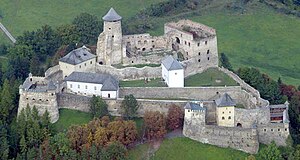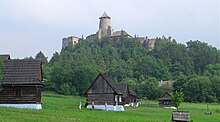Lublau Castle
| Lublau Castle | ||
|---|---|---|
|
Aerial view of the castle |
||
| Alternative name (s): | Lublau Castle | |
| Creation time : | late 13th century | |
| Castle type : | Hilltop castle | |
| Conservation status: | receive | |
| Place: | Stará Ľubovňa , Slovakia | |
| Geographical location | 49 ° 18 '55 " N , 20 ° 41' 58" E | |
| Height: | 548 m nm | |
|
|
||
The Lublauer Burg ( Slovak Ľubovniansky hrad , German also Lublauer Schloss , Hungarian Lubló vára , Polish Zamek Lubowelski ) is a hilltop castle above the Slovak town of Stará Ľubovňa in the Upper Zips . It is a national cultural monument of Slovakia.
history
The castle was built in the late 13th century or early 14th century and was one of the protective castles that were supposed to protect trade routes to Poland and at the same time secure northern borders of the Hungarian state , similar to the Arwa Castle west of the Tatra Mountains and castles in Niedzica (now in Poland) and Plaveč east of it. According to some sources, the Polish prince Boleslaw had the castle built in 1280, according to others it was the Hungarian king Andrew III. who ordered its construction in 1294. At this time the circular tower and the Gothic palace were built.
Shortly after the death of Andreas in 1301 and the creation of oligarchic domains , the castle came to the Aba dynasty , who controlled what is now eastern Slovakia, and held it until it was conquered by the army of Charles Robert of Anjou in 1312, shortly before the devastating defeat of the Aba at the Battle of Rozhanovce . It was only at this time that the castle was mentioned in writing, in 1311 as castrum Liblou . In the period up to 1412 ownership changed constantly between the crown and different sexes such as Drugeth , before it was again confiscated by the king as a border fortress in 1410.
A special year in the history of the castle is 1412: in March there was a meeting between the Hungarian king and Roman emperor Sigismund of Luxembourg and the Polish king Wladislaw II to sign a Polish-Hungarian protection treaty. When Sigismund needed credit to finance his wars against Venice, he had the castle, together with 13 Spiš cities, pledged to Poland from November 1412 in return for a loan of 37,000 Prague groschen . Although the debt should be repaid in a short time, the pledge was extended until 1772 ( First Partition of Poland ). During the lease, the nominal affiliation of the castle and its territory remained with the Kingdom of Hungary, but the Polish king had economic control, appointed castellans (see Starost ) and levied taxes.
In the first half of the 15th century, the surrounding area was devastated and the castle was damaged during the fighting between the Hussites and castellans. Since the fortress was outdated against artillery, more bastions and towers had to be built. The expansion began at the beginning of the 16th century under the direction of the castellan Peter Kmita , but until 1522 the rate of expansion was rather moderate due to numerous changes in leases. Only under Peter Kmita (not to be confused with the earlier one) the expansion was accelerated and, under the influence of Italian architects, bastions, further representative rooms and the lower courtyard were added. After Kmita's death in 1553, almost the entire castle burned down. The reconstruction was used to create a modern anti-Turkish Renaissance fortress, but also a comfortable residence for castellans; by 1557 the main work had been completed. Among other things, a water pipe was installed for the first time.
After further changes, the castle came to the Polish noble Lubomirski family in 1591 , who kept the castle for a century and a half. Under their rule, the castle was expanded, sometimes at the expense of the surrounding Spiš cities, which were increasingly exploited. In the course of the repeated raids on Poland in 1655–60 , Polish crown jewels were brought to safety thanks to Jerzy Sebastian Lubomirski from Warsaw to Lublauer Burg in 1655 and stayed there until 1661. In 1658 the Polish Imperial Council ( Sejm ) even declared the castle to be one of the six Polish fortresses, which should be maintained at state expense.
After Theodor Lubomirski's death in 1745, the castle came back to the Polish crown and grandiose plans for further expansion were drawn up, but in the end it was only a repair that lasted until 1760. After the First Partition of Poland, the castle was returned to Hungary in 1772. Since the former Polish Galicia came to the Habsburg Monarchy during the partition , the castle slowly fell into disrepair, as it was no longer near the border and was also partially damaged. A barracks and later a warehouse were housed there before the castle with the dominion was sold to the nobleman Raisz in 1819. In 1880 the family left the castle complex to the city of Alt-Lublau due to high maintenance costs, but the city of Alt-Lublau ran out of money and thus the Polish Count Zamoyski acquired the castle in 1883 and kept it for his representative rooms. During the Second World War, and particularly the Slovak National Uprising , the Gestapo arrested, examined and tortured partisans captured in the castle.
In 1945 the castle was confiscated by the Czechoslovak state and shortly afterwards became the location of a school. After their departure, the castle came into the possession of the local museum in 1956, which began with its repair and finally opened the castle to the public in 1966. An archaeological investigation began in the 1970s and, after a brief interruption, was continued after 1989, as did further repairs to the castle.
Today the castle is managed by the Ľubovňa Museum, together with the open-air museum under the castle hill.
Web links
- Description on www.hrady.sk (Slovak)
- Description on www.zamky.sk (Slovak)




